OBSTEYRC INSTRUCTIONS
CORD-CLAMP (DISPOSABLE)
- It is made of plastic and is supplied in a sterile pack. The serrated surface and the lock make its grip firm. It occludes the umbilical vessels effectively. The cord clamp is to be kept in place until it falls off together with the detached stump of umbilical cord.

&simid=608019678202311035&form=IRPRST&ck=DDEAE54A283CDB4A52030F4E0ED9309D&selectedindex=2&ajaxhist=0&ajaxserp=0&vt=0&sim=11&pivotparams=insightsToken%3Dccid_bj8uK99Q*cp_D915109198822AE5EA657D0228C380DC*mid_40F55ADCA80441E1D4D8D293B62C412887948A16*simid_607987448781955269*thid_OIP.bj8uK99Q47yWzP-7lcUvtAAAAA&iss=VSI) PINARD'S STETHOSCOPE
PINARD'S STETHOSCOPE
- It should be held firmly at right angle to the point on the abdominal wall. The ear must be firmly closed to the aural end. It should not be touched by hand while listening.

PERFORATOR (OLDHAM'S)
- The instrument is required in craniotomy to perforate specific the skull bone for decompression of the fetal head.

GIANT VULSELLUM
- It is used in destructive operation, especially in evisceration to have a good grip of the fetal parts for giving tracton.

MUCUS SUCKER
- Disposable
- Metal
- It is used to suck out the mucus from the naso-oropharynx following delivery of the head of the baby. To be of value, the mucus should be sucked prior to the attempt of respiration, otherwise the tracheobronchial tree may be occluded leading to inadequate pulmonary aeration and development of asphyxia neonatorum. The metal sucker requires a sterile simple rubber catheter to be fItted at one end of a sterle pIece of gauze to the other end.
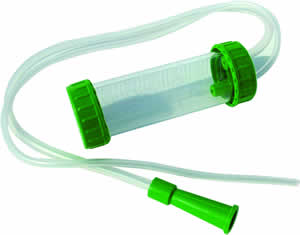
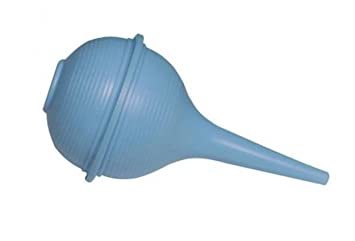
GREEN-ARMYTAGE HEMOSTATIC FORCEPS
- It is a long metallic instrument. The handle has rachet and catch system. The other end is broad and has transverse serrations. This end is for holding the tissues.
- This forceps is used in lower segment cesarean section. Total four forceps are ordinarily required-one for each angle and one for each flap. Its functions are hemostasis and to catch hold of the margins so that they are not missed durng suture.

VENTOUSE CUP WITH TRACTION DEVICE
- It is used in the operation of vacuum extraction of the head. The cup is to be fitted to the scalp of the fore coming head by producing "chignon" with the help of vacuum. The cup has got various sizes.

EPISIOTOMY SCISSORS
- It is bent on edge. The blade with blunt tip goes inside the vagina.

FORCEPS' AXIS TRACTION DEVICES
- It includes axis traction rods (right and left) and handle. The rods are assembled in the blades of long curved obstetric forceps prior to introduction and lastly the handle is attached to the rods. The devices are required where much forces are necessary for traction as in mid-forceps operation. These are less commonly used now.

KIELLAND'S FORCEPS
- It is usually used as rotation forceps in deep transverse arrest of occipito-posterior position of the head or in unrotated vertex or face presentation.

SHORT-CURVED OBSTETRIC FORCEPS (WRIGLEY'S FORCEPS)
- It can only be used as outlet forceps for extraction of the head.

MANUAL VACUUM ASPIRATION (MVA) SYRINGE
- This is used for evacuation of the uterus by creating a vacuum. It is used up to 12 weeks of pregnancy for medical termination.

LAMINARIA TENT AND THE TENT INTRODUCING FORCEPS WITH LAMINARIA TENT
- The instrument is almost similar to uterine dressing forceps. There is a groove on either blade to catch the laminaria tent.
- Laminaria tent: It is dehydrated, compressed, Chinese sea-weeds. It is sterilized by keeping it in absolute alcohol at least for 24 hours. Usually, more than one tent is to be introduced to prevent dumbling of the ends. It produces slow dilatation of the cervical canal, as it swells up due to hygroscopic action.
- Isabgol tents (Isogel): It is dried granules prepared from the husks of "certain mucilaginous tropical seeds".

UTERINE DRESSING FORCEPS
- The instrument is most often confused with laminaria tent introducing forceps. The blades are transversely serrated. while in the latter, there is a groove on either blade.
- To swab the uterine cavity following D+E with samll-gauze pieces
- To dilate the cervix in lochiometra or pyometra

UTERINE CURETTE
- It is a long metallic instrument with a small fenestrated end at each side. The shaft is there in the middle.
- It may be sharp at both ends or sharp at one end and blunt at the other. Its common use in obstetrics is in the operation of D+C for incomplete abortion.

KELLY'S LONG FORCEPS
- This is long metallic instrument. It has a smooth curve close to the blades. The handle has no catch. The blades are fenestrated with transverse serrations on its inner surface.
- Uses- Postplacental (following delivery of the placenta), insertion of IUCD (Cu T380 A) in the puerperal uterus.
- Alternatve to ovum forceps for removal of retained pacental bits and membranes.
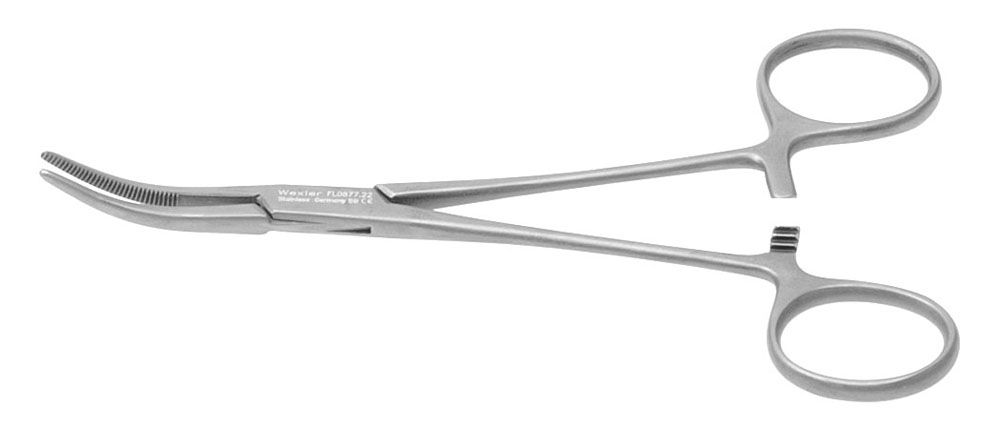
OVUM FORCEPS
- It is a long metallic (steel) instrument with two ends and a shaft. The handle has no catch and the blades are slightly bent and fenestrated. Absence of catch minimizes uterine injury, if accidentally caught. It prevents crushing of the conceptus. It is to be introduced with the blades closed, to open up inside the uterine cavity, to grasp the products and to take out the instrument with a slight rotatory movement.

SPONGE-HOLDING FORCEPS
- It is a long metallic instrument (steel). It has two ends. (1) One end is the handle with rachet and catch. (2) The other end is ring-shaped with transverse serrations inside for better grip.
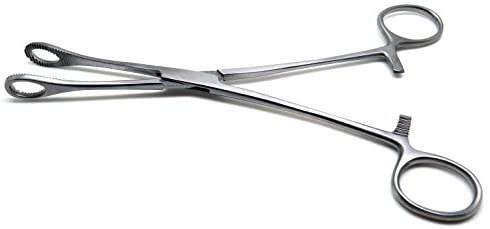
Uses:
- To clean the vulva, vagina and perineum prior to and following delivery.
- Antiseptic painting of the abdominal wall prior to cesarean section.
- To catch hold of the membranes if it threatens to tear during delivery of the placenta.
- To catch hold of the cervix.
- To catch hold of the cervx durng encrclage operation.
DOYEN'S RETRACTOR
- It is a long metallic instrument with a stout handle at one end. The other end has a wide retracting blade (fan-shaped and curved). It needs an assistant to hold and to retract.

Uses-
- It is used to retract the abdominal wall as well as the bladder for proper exposure of lower uterine segment during LSCS. It is to be introduced after opening the abdomen; to be temporarily taken off while the baby is delivered.
FLUSHING CURETTE
- It is a blunt curette used in the operation of D + E. Previously, it was used to flush the uterine cavity with luewarm antiseptc solution-passing through the communication channel.

CERVICAL DILATORS:- HAWKIN AMBLER AND DAS OR HEGAR'S DILATORS
- Hawkin-Ambler: It is a single-ended metallic cervical dilator. It has got 16 sizes, the smallest one being 3/6 and the largest one being 18/21. The number is arbitrary in the scale of Hawkin-Ambler. The smaller one denotes measurement at the tip and the larger one measures the maximum diameter at the base in mm.
- Das or Hegar's dilator is a double-ended one. The mini-mum size is 1/2 and the maximum size is 11/12. The number represents the diameter in mm. Both the sides are used with the lower number first.
- Use-It is used in dilatation of the cervical canal prior to evacuation operation.

UTERINE SOUND
- It is an olive pointed, graduated, malleable, metallic uterne sound. As it is malleable, its curvature could be changed to adapt the position of the uterus and for ease of introduction.

Uses:
- To know the position of the uterus and the length of the uterine cavity prior to dilatation of the cervix in D+ E operation.
- To sound the uterine cavity to detect any foreign body.
- It acts as a first dilator of the cervical canal.
LONG STRAIGHT SCISSORS
- Uses:- to It is commonly used to cut the umbilical cord,
- to make episiotomy,
- to cut suture materials as in cesarean section.

KOCHER'S HEMOSTATIC FORCEPS
- This instrument has a tooth at the end of one blade and a groove on the other so as to have a firm grip. The handles have the catch.

Uses:
- To clamp the umbilical cord-for better grip and effective crushing effect to occlude the vessels.
- In low rupture of the membranes as surgical induction of labor or augmentation of labor.
- Can be used as a hemostatic and pedicle clamp during hysterectomy.
LONG STRAIGHT HEMOSTATIC FORCEPS
- This is not commonly used in obstetrics. It can be used to clamp the pedicle while removing the uterus as in rupture uterus. The umbilical cord may be clamped as an alternative to Kocher's.

ALLIS TISSUE FORCEPS
Uses:
- To catch hold of the anterior lip of the cervix in D+E operation.
- To hold the apex of the episiotomy wound during repair.
- To catch hold of the margins of the peritoneum, rectus sheath, vaginal mucosa during repair.
- To catch hold of the torn ends of the sphincter ani externus prior to suture in repair of complete perineal tear.
- To catch hold of the margins and angles of the uterine flaps in LSCS after delivery of the baby as an alternative to green- Armytage hemostatic clamp.
MULTIPLE TOOTHED VULSELLUM
- It is used to catch hold of the anterior lip of the cervix in (a) D + E operation, (b) suction evacuation . As it produces trauma to the soft and vascular cervix, Allis tissue forceps may be used instead.

CUSCO'S BIVALVE SELF-RETAINING VAGINAL SPECULUM
It has two blades joined by screws to allow the blades to open and close. The blades are concave inside. the handles are designed to open and close the blades with a separate rod and screw system. this makes the blades self-retaining during examination. It does not need an assistant to hold it.
- To visualize the cervix and vaginal fornices for any local cause (polyp, ectopy) of APH.
- To inspect the cervix and to prepare cervical smear for cytology screening.
- To detect leakage of liqor from the cervical Qs in a case of suspected PROM.

SIMS' DOUBLE-BLADED POSTERIOR VAGINAL SPECULUM
- This double bladed speculum has a groove in the handle. This groove is in continuity at either end with the concave inner surface of the blade. The purpose of the groove is to allow drainage of blood, urine, or to collect such samples for test.
- The blades are of unequal breadth to facilitate introduction into the vagina depending upon the space available.

It is used in obstetrics:
- To inspect the cervix and vagina and to detect any injury following delivery. To clean the vagina following delivery.
- To inspect the cervix and vagina to exclude any local cause for bleeding in APH (Cusco's speculum preferred).
- During D and E operation.
FOLEY'S CATHETER
It is made of silicon rubber. The catheter tip has two slit openings, one on either side for drainage of urine. uterine The other end goes to the urinary bag to collect urine. The catheter has two channels within. One for urine drainage and the other is used to push water that inflates the catheter bulb. This inflated bulb makes the catheter self retaining. The catheters are of different sizes. The commonly used catheters in female are: 14F, 16 F or 18F. These are dispo sable.
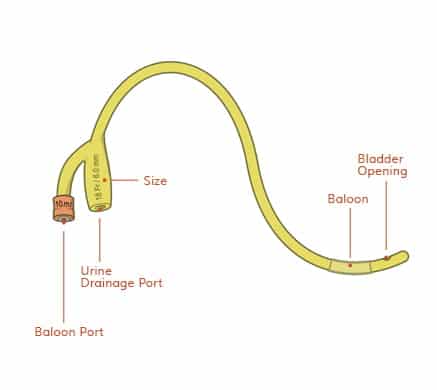
Uses:-
It is used for continuous drainage of bladder in cases with-
- Eclampsia.
- Retroverted gravid uterus.
- To give rest to the bladder following any destructive operation and/or in a case with suspected bladder injury. It is usually kept for 7-10 days.
- In the management of atonic PPH.
- To control atonic PPH.
SIMPLE RUBBER CATHETER
- It is made of rubber. It has different sizes. Slit openings, usually two (one on either side) are present close to the tip.
- Sterilization:-Boiling

Uses:-
It is used to empty the bladder in cases with retention of urine
- Pregnancy (Retroverted Gravid Uterus).
- Labor-(i) when the woman fails to pass urine by herself, (ii) before and after any operative interventions (forceps delivery) destructive operations.
- Postpartum-(i) during management of postpartum hemorrhage, (ii) retained placenta. B. Other uses-(a) as a tourniquet, (b) to administer O₂ when nasal catheter is not available, (c) as a mucus sucker-when it attached to mechanical or electric sucker.
Needle Holder
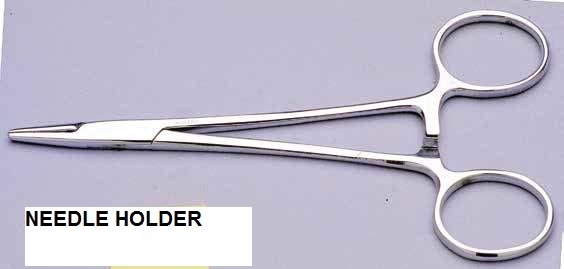
INDICATIONS
- This instrument is used for grasping needle at the time of suturing.
- The inner surface of tip has serrations and a small grove for firm grasp of the curved needle.
- The box joint is placed very close to tip to give adequate pressure because of the lever effect.
Cord Cutting Scissor

Lanes tissue forceps
INDICATIONS
- To hold parietal wall (bulk of tough tissues) for retraction during abdominal operations with transverse incision
- To hold the polyp or fibroid in polypectomy or myomectomy operations
- To hold the towel during draping

